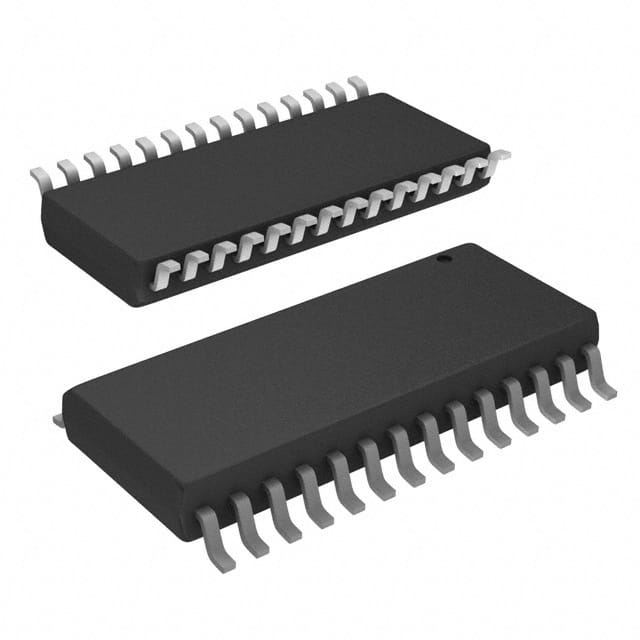AT28HC256-12SI
Product Overview
Category
AT28HC256-12SI belongs to the category of high-speed, low-power Electrically Erasable Programmable Read-Only Memory (EEPROM) chips.
Use
This product is primarily used for non-volatile data storage in various electronic devices such as microcontrollers, computers, and consumer electronics.
Characteristics
- High-speed operation: The AT28HC256-12SI offers fast read and write speeds, making it suitable for applications that require quick access to stored data.
- Low power consumption: This EEPROM chip is designed to minimize power usage, making it ideal for battery-powered devices.
- Large storage capacity: With a capacity of 256 kilobits, the AT28HC256-12SI provides ample space for storing critical data.
- Reliable data retention: The chip ensures data integrity even in harsh environmental conditions.
Package
The AT28HC256-12SI comes in a Small-Outline Integrated Circuit (SOIC) package. This package type allows for easy integration into circuit boards and provides mechanical protection to the chip.
Essence
The essence of the AT28HC256-12SI lies in its ability to store and retrieve data reliably and quickly, while consuming minimal power.
Packaging/Quantity
This product is typically packaged in reels or tubes, with each containing a specific quantity of chips. The exact packaging and quantity may vary depending on the manufacturer's specifications.
Specifications
- Operating voltage: 2.7V to 5.5V
- Access time: 120 ns
- Standby current: 10 µA (typical)
- Write endurance: 100,000 cycles
- Data retention: 10 years
Detailed Pin Configuration
The AT28HC256-12SI has a total of 28 pins, which are assigned specific functions. The pin configuration is as follows:
- A0 - Address Input
- A1 - Address Input
- A2 - Address Input
- A3 - Address Input
- A4 - Address Input
- A5 - Address Input
- A6 - Address Input
- A7 - Address Input
- A8 - Address Input
- A9 - Address Input
- A10 - Address Input
- A11 - Address Input
- A12 - Address Input
- A13 - Address Input
- A14 - Address Input
- /OE - Output Enable
- /WE - Write Enable
- /CE - Chip Enable
- I/O0 - Data Input/Output
- I/O1 - Data Input/Output
- I/O2 - Data Input/Output
- I/O3 - Data Input/Output
- I/O4 - Data Input/Output
- I/O5 - Data Input/Output
- I/O6 - Data Input/Output
- I/O7 - Data Input/Output
- Vcc - Power Supply
- GND - Ground
Functional Features
- High-speed operation allows for quick access to stored data.
- Low power consumption ensures efficient use of energy in battery-powered devices.
- Reliable data retention guarantees the integrity of stored information over extended periods.
- Easy integration into circuit boards due to the Small-Outline Integrated Circuit (SOIC) package.
Advantages and Disadvantages
Advantages
- Fast read and write speeds
- Low power consumption
- Large storage capacity
- Reliable data retention
- Easy integration into circuit boards
Disadvantages
- Limited write endurance (100,000 cycles)
- Higher cost compared to other non-volatile memory options
Working Principles
The AT28HC256-12SI utilizes EEPROM technology to store and retrieve data. It employs a combination of electrically controlled gates and floating gate transistors to achieve non-volatile memory functionality. When data is written, charges are trapped in the floating gate, altering the transistor's behavior and storing the desired information. During read operations, the stored charges are detected, allowing the retrieval of the stored data.
Detailed Application Field Plans
The AT28HC256-12SI finds applications in various fields, including:
- Microcontrollers: Used for program storage and data logging.
- Computers: Employed for BIOS (Basic Input/Output System) storage and firmware updates.
- Consumer Electronics: Utilized for configuration settings, calibration data, and firmware storage in devices such as smartphones, tablets, and digital cameras.
Detailed and Complete Alternative Models
- AT28C256-15PU: Similar to the AT28HC256-12SI but operates at a slower speed (150 ns).
- AT28HC256E-90SU: Offers extended temperature range (-40°C to 85°C) compared
Senaraikan 10 soalan dan jawapan biasa yang berkaitan dengan aplikasi AT28HC256-12SI dalam penyelesaian teknikal
Sure! Here are 10 common questions and answers related to the application of AT28HC256-12SI in technical solutions:
Q: What is the AT28HC256-12SI? A: The AT28HC256-12SI is a high-speed, low-power CMOS 256K (32K x 8) EEPROM memory chip.
Q: What is the operating voltage range for the AT28HC256-12SI? A: The AT28HC256-12SI operates within a voltage range of 4.5V to 5.5V.
Q: What is the maximum clock frequency supported by the AT28HC256-12SI? A: The AT28HC256-12SI supports a maximum clock frequency of 12 MHz.
Q: Can the AT28HC256-12SI be used in automotive applications? A: Yes, the AT28HC256-12SI is suitable for automotive applications as it can withstand harsh environmental conditions.
Q: How much data can the AT28HC256-12SI store? A: The AT28HC256-12SI has a storage capacity of 256 kilobits or 32 kilobytes.
Q: Is the AT28HC256-12SI compatible with microcontrollers? A: Yes, the AT28HC256-12SI is compatible with most microcontrollers that support SPI or I2C communication protocols.
Q: What is the typical write endurance of the AT28HC256-12SI? A: The AT28HC256-12SI has a typical write endurance of 100,000 cycles.
Q: Can the AT28HC256-12SI operate at high temperatures? A: Yes, the AT28HC256-12SI can operate at temperatures ranging from -40°C to +85°C.
Q: Does the AT28HC256-12SI support hardware data protection? A: Yes, the AT28HC256-12SI provides hardware data protection features like a write protect pin and software write protection.
Q: Can the AT28HC256-12SI be used in battery-powered devices? A: Yes, the AT28HC256-12SI is designed for low-power applications and can be used in battery-powered devices.
Please note that these answers are general and may vary depending on the specific application and requirements.


